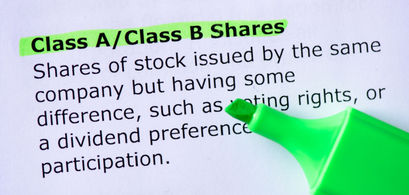Definition
The terms Class A and Class B stock refer to common or preferred shares issued by the same corporation that offer their holders different rights. For example, each class of stock might differ with respect to the shareholders' voting rights or the payment of dividends.
Explanation
Typically, the charter of a company will outline the types of common stock it may issue. One common misconception is Class B stock is always subordinate to Class A; this is not always true. Companies will oftentimes offer different classes of stock to protect the voting rights of certain shareholders.
For example, a family owned business that is now a publicly traded company might offer two classes of stock. The original owners might retain Class B stock, providing them with ten votes for each share held, while Class A stock is issued to the public and provides one vote per share. This arrangement allows the original owners to retain significant voting rights while holding fewer shares. In well-run companies, voting rights should not be a concern for shareholders.
Companies can also use different classes of stock to differentiate or prioritize the payment of dividends. For example, Class A stock might be paid dividends before payment is made to holders of Class B stock. Similarly, one class of stock might be paid at a higher dividend rate than another.
Investors can quickly distinguish between classes of stock by looking at the ticker symbol. Berkshire Hathaway Class A will have the symbol BRK.A, while the symbol for its Class B stock is BRK.B.



